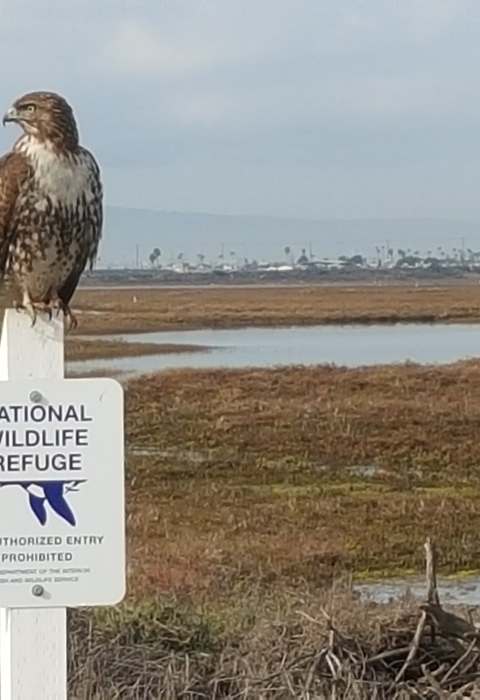The predominant native habitats within the South San Diego Bay Unit include shallow subtidal habitat and intertidal mudflats. In addition, the salt ponds provide resting and foraging habitat for a variety of avian species, while the levees around the ponds provide important nesting habitat for seven species of ground nesting seabirds. Based on observations of these nesting colonies, it appears that the ground nesting seabirds prefer limited human disturbance, isolation, availability of exposed or lightly vegetated open ground, and unrestricted visual access from the levees into the surrounding area. In San Diego Bay, shallow subtidal habitat supports an abundance of fish, and bird abundance and diversity is higher in this habitat than in any other subtidal habitats in the bay. Within the boundaries of the South San Diego Bay Unit, there are areas of vegetated and unvegetated shallow subtidal habitat. Eelgrass beds, which make up much of the vegetated areas within this habitat, also occur within the Refuge boundary. Eelgrass beds provide highly productive microhabitats for a wide variety of invertebrates and small fish. Eelgrass provides food both directly and indirectly to a wide array of organisms. It can enter the food web as detritus, be eaten by fish that are sometimes eaten by fish-eating birds, or be consumed directly by birds, such as black brant, gadwall, and northern pintail. The bay’s small population of Eastern Pacific green sea turtles also relies on eelgrass as an important food source. The density and biomass of the South Bay’s eelgrass beds can vary widely from one season to another and are affected by water depth, sediment grain size, nutrients, light levels, temperature, salinity, and water quality.
The South Bay’s shallow subtidal habitat also supports a group of twelve species of fish that are indigenous to the bays and estuaries of the Southern California Bight. The extensive shallow water habitat and eelgrass beds of the South Bay provide important habitat for these and a variety of other fish, including midwater, schooling fishes, such as northern anchovies, slough anchovies, and topsmelt. These species, in turn, represent a major forage resource for predatory fish and avian species. The warmer, hypersaline waters of the South Bay also offer shelter for a number of fish species commonly encountered further south in the Eastern Subtropical and Tropical Pacific. The south end of San Diego Bay also appears to function as an important nursery area for juvenile California halibut and young spotted and barred sand bass.
Intertidal mudflats provide foraging habitat for fish during high tide, while at low tide, great numbers of shorebirds assemble to forage on the many invertebrates available on the exposed flats. In addition to foraging, shorebirds also depend upon the mudflats for roosting and resting. The most extensive mudflats within the South Bay are those that lie to the north of the salt ponds within the Refuge Unit. The Service observed tens of thousands of birds, representing 67 species, in this area during a year-long survey conducted in 1993 and 1994. The majority of the birds observed were shorebirds and seabirds. Smaller areas of coastal salt marsh salt marsh
Salt marshes are found in tidal areas near the coast, where freshwater mixes with saltwater.
Learn more about salt marsh occur in the few natural drainages that flow through the Refuge Unit, as well as along the bayside of the outer levees of the salt ponds. This habitat provides the Belding’s savannah sparrow with nesting and foraging opportunities. Within the lower reach of the Otay River, this habitat as well as some brackish and freshwater marsh areas, provide habitat for the endangered light-footed Ridgway's rail, various shorebirds, and wintering and breeding waterfowl.
Although not considered a natural habitat, the salt evaporation ponds located within the South San Diego Bay Unit provide relatively isolated nesting and resting habitat for a wide range of avian species, as well as some unique foraging habitat for several species of birds. Solar salt production has occurred in this location for over 100 years. During this time, the salt ponds have been an important stopover point for large numbers of migratory and wintering birds. In addition, the salt pond levees provide regionally important nesting habitat for seven species of colonial seabirds.
Due to the hypersaline nature of the ponds, native wetland vegetation and bay invertebrates are essentially absent from the majority of the ponds. The only fish in the ponds are those that come in with the initial intake of tidal water. Once in the system, they can only survive in the lowest salinity primary ponds, cannot escape back into the bay, and do not reproduce. The ponds do however support several species of brine invertebrates that are preyed upon by a variety of birds, particularly eared grebes and phalaropes.



